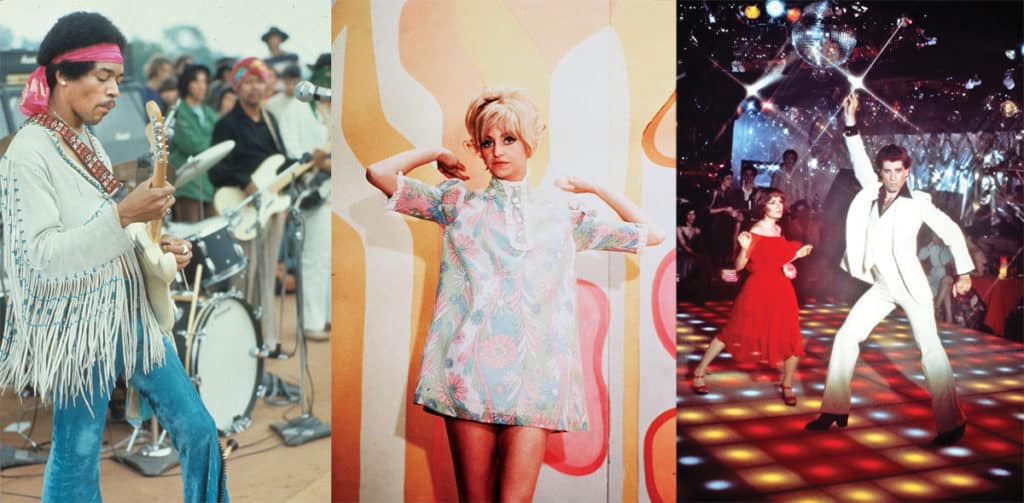
Every decade, certain styles emerge as the most fashionable of the day. The ’50s can be characterized by Bobby socks and poodle skirts; in the ’80s oversized blazers and big hair were in fashion. Several dominant styles define the era of the late ’60s and early ’70s, each simultaneously creating and reflecting a wave of change in the culture.
Grab your miniskirt and love beads and take a retro walk down memory lane.
Hippie
Perhaps the most iconic look associated with the ’60s and ’70s is that of the hippies. The hippie lifestyle was characterized by rebellion against authority, rejection of wealth and opposition to war in favor of peace, drugs and free love. Clothing was bright and colorful, and mixing patterns was in vogue. Tie-dye clothing is closely associated with the counterculture, as were bellbottom jeans—the wider, the better.
Psychedelic patterns became prevalent in the late ’60s. The Beatles’ Sergeant Pepper’s Lonely Hearts Club Band captured the beginning of what’s known as the ‘Summer of Love.’ Jimi Hendrix embraced the movement and created a distinctive image for himself which often featured outrageous prints, colorful scarves and vests, groovy jackets, frilly shirts and bellbottom pants, as well as military-inspired elements to display his anti-establishment and anti-war stance.

African-American men and women embraced the afro hairstyle, associated with the Black Is Beautiful cultural movement. The “flower children” of the era could often be seen in peasant blouses and long, flowing skirts, and were commonly decked out in peace symbols, headbands and long beaded necklaces, known as love beads. Both genders could be seen in suede fringed jackets and vests and other accessories inspired by Native American motifs. Hippies favored long hair and minimal footwear, including sandals, moccasins or foregoing footwear all together.
See Easy Rider (1969), Woodstock (1970) and Hair (1979) for examples of flower children and free spirits.

Mod
The mod subculture began in London in the ’50s and spread throughout Great Britain and the United States in the ’60s. This era is closely associated with model and pop culture icon Twiggy, miniskirts and bold geometrical patterns on brightly colored clothes. Twiggy popularized the futuristic style of the white go-go minidress with knee-high boots and cropped pixie hair. Sex symbol Brigitte Bardot epitomized ’60s hair with soft messy waves, long parted bangs and a small bouffant. American women looked to Goldie Hawn and Judy Carne on Rowan & Martin’s Laugh-In as style icons of mod fashion. Makeup emphasized the eyes with big lashes taking center stage, with youthful pale pink and white hued lipsticks to complete the look.
The British invasion had a lot to do with the mod look hitting the U.S. On men, the mod look could include slim-fitting suits with narrow pants and lapels, polo or Oxford button-down shirts, Madras plaid shirts or pants, well-pressed chinos, a cable knit sweater, Harrington jacket, a skinny knitted tie, penny loafer shoes and tortoiseshell sunglasses. Think Brian Jones of The Rolling Stones or Steve McQueen.
A Hard Day’s Night (1964) was a seminal influence on mod style and Blowup (1966) is considered a mod masterpiece.

Disco
The disco craze that swept the country in the ’70s spawned a corresponding fashion craze.
Men strutted around the dance floor in tight bellbottoms—very often white, as opposed to the blue jeans of previous decades—and muscle-hugging shirts with gold chains. White suits with plunging necklines and wide lapels were common. When not in bellbottoms with halter-neck tops, women most often wore slinky knee-length wrap dresses. Jumpsuits and platform boots were popular with both sexes, as were hot pants and top-to-bottom gold lamé. The hippest men and women wore busily patterned polyester or nylon Huck-A-Poo brand button-down shirts. Big, bold patterns epitomized the disco era, as did big,dangling earrings.
Check out Saturday Night Fever (1977) and 54 (1998) for live-action examples of disco fashion.
Generation. (Album art)
album art)
Punk
The antithesis to the aforementioned fads, punk style was defiantly anti-materialistic, with preference for dirty-looking, simple clothes and secondhand fashions. The Ramones made the T-shirt, jeans and leather jacket combo a staple of the look. Some takes on the punk rock look included deliberately offensive images on T-shirts, purposely ripped clothing, fishnet stockings, studded and spiked jewelry and heavy eyeliner.
Punk fashion, established by artists like Lou Reed, the Ramones, Suicide, Sex Pistols and the New York Dolls, influenced designers of the day. Artist, musician, band manager and clothes designer Malcolm McLaren credits his style to punk rock innovator Richard Hell, whose aesthetic included pegged black jeans, torn T-shirts and frayed clothes held together with safety pins. British fashion designer Vivienne Westwood is largely responsible for bringing fashions of the punk scene into the mainstream. The punk movement also saw the emergence of body piercings and rise of tattoos among the populace.
Documentary New York Doll (2005) and film Blank Generation (1980) chronicle the early days of punk.




































